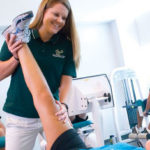UWF uses technology to engage students
"Are you paying attention?" is a simple question for a professor to ask a classroom full of students, however, getting answers can be difficult. There may be a few raised hands or some blank stares, but it's likely for professors to feel they've reenacted a popular scene from the movie Ferris Bueller's Day Off-"Bueller, Bueller." The University of West Florida is now armed to facilitate more student engagement. The secret weapon: Turning Technologies Classroom Response System.
“Are you paying attention?” is a simple question for a professor to ask a classroom full of students, however, getting answers can be difficult. There may be a few raised hands or some blank stares, but it’s likely for professors to feel they’ve reenacted a popular scene from the movie Ferris Bueller’s Day Off-“Bueller, Bueller.” The University of West Florida is now armed to facilitate more student engagement. The secret weapon: Turning Technologies Classroom Response System.
Also known as a student response system or audience response system, Turning Technologies’ Classroom Response System integrates seamlessly into Microsoft PowerPoint, allowing students to participate in presentations and lectures by submitting responses to interactive questions and prompts using a Response Card keypad, or “clicker.”
“This technology transforms the way instructors deliver and students receive PowerPoint presentations,” said Michael White, manager of Instructional Technology at UWF. “The response system is a powerful engagement tool that collects real-time responses, dramatically enhancing learning outcomes.”
According to White, the goal is to encourage students actively to participate and develop critical thinking skills. Many instructors, as they learn to use the system effectively, start out by asking questions that focus on rote memorization. As instructors become more comfortable using this teaching tool, they generally progress into the more advanced uses, such as analysis and synthesis.
Student response systems have been available to institutions of higher learning for many years. White said some instructors at UWF have used them in the past, but with limited applications. UWF began testing Turning Technologies in the fall of 2008, and there are approximately eight instructors who are actively using the system which has been in full production since the beginning of fall 2009. Another eight to 10 instructors are planning to adopt it for the upcoming spring semester.
“The current implementation is the most comprehensive effort to date to institutionalize student response systems at UWF,” said White. “The university is now in full production and any instructor who wants to use the Turning Technologies may do so. The current plan is to target instructors who teach survey courses or general studies courses. For example, general psychology, general biology and general botany are excellent examples of courses that fit these criteria.”
White advised there is no particular subject matter that is more suited for this technology over another. More so, instructors of all disciplines must evaluate what they wish to accomplish with the technology and then implement curriculum and teaching methods that support those goals and objectives. Diane Gardner, chairwoman for the UWF Department of Nursing, said she is thrilled to begin using the “clickers” in her classroom. In fact, starting in the spring 2010 semester, all required nursing classes for junior nursing majors will incorporate the student response system.
“The ‘clickers’ are going to be so helpful for preparing students for NCLEX, the national board exam for nursing,” she said. “It will allow instructors to put up sample questions and immediately gauge students’ comprehension of the material.”
Students may purchase a “clicker” in the university book store. Then, all they need to do is bring it to class.
For more information, visit uwf.edu/its/instructionandresearch/classroomresponse.cfm or contact White at mwhite@uwf.edu.
Written by Lauren Smith, University Marketing Communications


